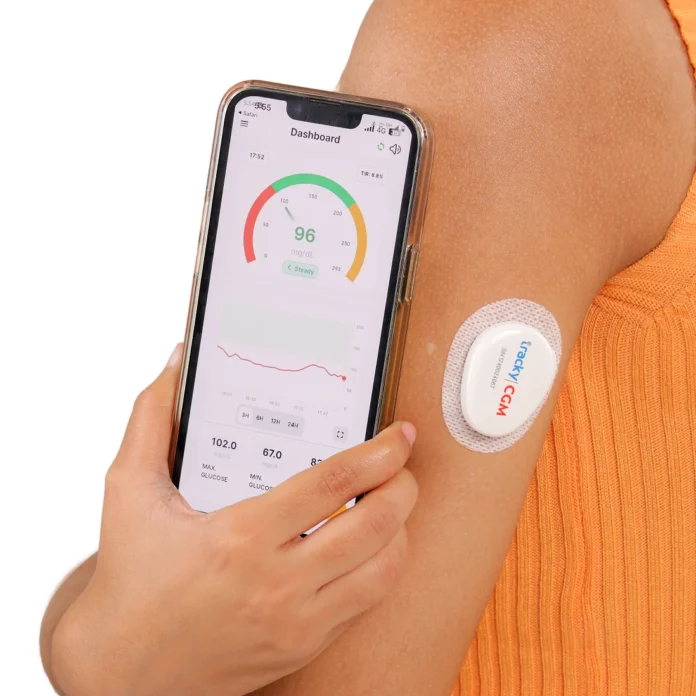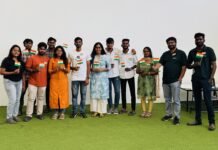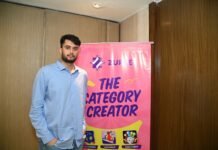Founded by: Neeraj Katare
Registered as: Drstore Healthcare Services India Pvt. Ltd.
Location: Thane, Maharashtra
The Problem That Couldn’t Be Ignored
India is the diabetes capital of the world. With over 101 million diagnosed diabetics and 136 million prediabetics, the scale of the crisis is staggering. Yet despite this massive burden, access to real-time, affordable, and patient-friendly glucose monitoring remains severely restricted.

For founder Neeraj Katare, the gaps in the market were impossible to ignore. Traditional diabetic management in India has long relied on painful finger-prick glucometers that patients often skip, or retrospective CGMs like FreeStyle Libre Pro that doctors review only after 14 days – offering no real-time insights to patients when they need them most.
“When we spoke to patients and diabetologists, one insight stood out,” Neeraj recalls. “People were making life decisions based on occasional fasting readings, unaware that they were missing spikes and dips throughout the day – especially post-meals and during sleep.”
Even among urban, tech-savvy users, compliance with scanning or pricking was poor, often due to fear, stigma, or lifestyle constraints. The problem was clear: existing solutions lacked real-time alerts and were either unavailable or cost-prohibitive in India, with prices upwards of ₹10,000-15,000 per sensor.
This wasn’t just a product opportunity. It was a public health necessity.
Building the Solution: Tracky CGM
Tracky CGM emerged as India’s first Bluetooth-enabled, real-time Continuous Glucose Monitoring system designed specifically for the Indian lifestyle, price sensitivity, and medical needs. The solution combines advanced biosensing technology with seamless digital connectivity to offer a user-friendly, affordable, and clinically reliable alternative to existing CGMs.
The Tracky system comprises two essential parts:
- Sensor: A wearable patch that continuously measures interstitial glucose
- Transmitter: A reusable, Bluetooth-enabled device that sits over the sensor and transmits data directly to the Tracky app
What truly sets Tracky apart is its real-time functionality. Unlike FreeStyle Libre 1, where users must manually scan the sensor to check glucose levels, Tracky streams real-time glucose data directly to the user’s smartphone. This eliminates the need for scanning and enables live alerts, trend tracking, and proactive action.
The features speak for themselves:
- Real-time alerts for hypo- and hyperglycemia
- Data syncing every 5 minutes with rich visualizations and time-in-range metrics
- AI-generated summaries that are clinically validated and doctor-shareable
- Connectivity with the Tracky Health App for monitoring food, exercise, sleep, and correlating them with glucose behavior
Most importantly, Tracky brings affordability without compromising on accuracy or features. The Tracky Welcome Kit (sensor + transmitter) is priced at ₹5,999, with sensor refills available for ₹3,899 – roughly one-third the cost of existing solutions.
The First Customer: A Validation Story
Tracky’s first customer came onboard during the early testing phase, even before commercial launch. During internal trials to fine-tune sensor accuracy and app integration, the team reached out to diabetics via their existing DrStore network.
One Type 2 diabetic agreed to try Tracky in its beta stage. He was curious but skeptical, having used traditional CGMs and experienced frustration with inconsistent data and manual scanning requirements.
The team worked closely with him through several iterations, improving sensor calibration, refining app features, and simplifying the user interface based on his feedback. For the first time, he could see in real-time how his post-meal spikes and overnight drops were impacting his overall control – insights his previous glucose monitoring tools never revealed.
The real success? Six months and several sensor cycles later, he’s still an active, paying Tracky user. His physician made smarter medication adjustments, and his overall engagement with diabetes management deepened.
This early validation reinforced the team’s belief that real-time, continuous, and affordable CGM was a long-overdue necessity for Indian diabetics.
Overcoming Early Hurdles: The Onboarding Challenge
One of the biggest early hurdles was educating users about Tracky’s two-part system. Most Indian users, familiar with single-piece systems like FreeStyle Libre 1, found this unfamiliar. Many initially ordered only the sensor, unaware that the transmitter was essential to activate and sync data to the app.
But this challenge revealed something deeper: beyond technical education, there was a need for guided onboarding and hand-holding, especially for first-time CGM users new to real-time monitoring.
To address this, Tracky has been actively building a multi-layered onboarding ecosystem:
Dedicated Support for Every User: A team focused solely on onboarding support, offering one-on-one guidance, how-to videos, and app navigation assistance.
Doorstep Application Services: In many cities, trained phlebotomists assist with sensor placement and initial setup through home-visit services.
Distributor & Doctor-Led Networks: Building a local distributor and clinic partner network to ensure accurate product information reaches even the most remote corners of the country.
Content-Rich Digital Touchpoints: Continuously improving online presence with clear product explanations, use-case driven videos, and multilingual FAQs.
“While we’ve made meaningful strides, this is still a work in progress,” Neeraj admits. “Because onboarding isn’t just a moment – it’s the foundation for lifelong trust.”
Finding Product-Market Fit
Achieving product-market fit was the result of continuous feedback and fast iteration. The team engaged closely with diabetologists, patients, and fitness communities to understand what was missing in existing CGMs. The need for real-time data, ease of use, and affordability came up consistently.
That led them to build Tracky with Bluetooth connectivity for real-time alerts, a simple onboarding experience, and AI-powered insights – all while keeping the price accessible.
As users started seeing real impact – catching post-meal spikes or adjusting lifestyle choices – adoption and retention followed. That’s when the team knew they were solving a real, unmet need.
What Makes Tracky Different
Tracky’s core USP lies in offering real-time CGM functionality at a fraction of the cost of international brands, without compromising on features. But it’s not just about affordability – it’s about empowering users through an app ecosystem designed to help them take control of their health with timely insights and actionable data.
Having worked in this segment for several years, the Tracky team has developed a deep understanding of the CGM market in India – not just from a product standpoint, but from the perspective of how people actually use (or don’t use) these technologies in their everyday lives. They’ve spoken to thousands of customers and hundreds of CGM promoters, giving them rich insight into what works, what frustrates users, and where existing solutions fall short.
“What makes us stand out is not just the product, but how we’ve designed, positioned, and supported it for Indian users,” Neeraj explains. “From onboarding and app design to pricing, home diagnostics integration, and caregiver-friendly features, we’ve created a solution that’s truly user-first.”
The focus goes beyond just hardware. Tracky is building a smart app ecosystem that empowers users with real-time insights and enables family members or caregivers to remotely track glucose data. This approach to connected, proactive care is what makes Tracky a trusted partner in diabetes management.
Lessons Learned: Building Healthcare in India
One of the most profound learnings has been that building healthcare products in India demands more than innovation – it demands empathy, cultural intuition, deep operational resilience, and an exceptional team.
Early on, the team believed that launching a high-tech, affordable solution would naturally lead to adoption. But they quickly learned that in Indian healthcare, the ‘what’ matters far less than the ‘how’ – how people discover your product, how they are guided through it, how supported they feel using it, and how trust is built over time.
They had to unlearn global assumptions around digital fluency, health literacy, and even something as basic as language and regional comfort. They realized that technology only works if it’s wrapped in simplicity, emotional security, and service. For example, the decision to invest in home-visit onboarding or family access features came directly from observing how caregiving works in Indian homes.
“We’ve learned that in a market like India, experience is the real differentiator,” Neeraj reflects. “It’s not just about advanced features – it’s about how simple, reassuring, and empowering the journey feels for the user. Trust, clarity, and consistent support matter just as much as the technology itself.”
The Vision: Beyond CGM
The big picture for Tracky goes far beyond CGM. The team is building a complete remote vitals monitoring ecosystem tailored to India’s unique healthcare challenges. The goal is to enable continuous, at-home monitoring of critical health parameters like glucose, cardiac markers, inflammation, and electrolytes, solving a significant pain point for hospitals, doctors, and chronic disease patients alike.
Tracky CGM is just the beginning – the foundation for a much larger platform that empowers early intervention, improves clinical decision-making, and reduces the burden on over-stretched healthcare infrastructure in both urban and rural settings.
The team is working toward manufacturing their devices in India, not just to support the Make-in-India vision, but to drive down costs and improve supply chain control. Parallelly, they’re investing in their tech ecosystem – building data science capabilities that can interpret patterns, generate predictive insights, and automatically alert the right stakeholders (patients, caregivers, doctors) at the right time.
“The future of health isn’t episodic – it’s continuous, connected, and intelligent,” Neeraj envisions. “That’s the future Tracky is building toward.”
Goals for the Next Six Months
The primary goal over the next six months is ambitious but clear: onboard at least 100,000 users onto Tracky CGM. Everything the team is working on – from strengthening support infrastructure to expanding outreach – is geared toward achieving this milestone and helping more individuals take control of their glucose health through real-time, affordable monitoring.
Advice to Fellow Entrepreneurs
“If there’s one thing I’ve learned, it’s that you have to fall in love with the problem, not the product,” Neeraj shares. “Especially in healthcare, things rarely go as planned. What you build on day one will probably change – and that’s okay. What shouldn’t change is your obsession with the problem you’re solving and the people you’re solving it for.”
For the Tracky team, every breakthrough came from staying close to the user – listening to their fears, their confusion, their lived realities. And often, that meant unlearning everything they thought they knew.
“Don’t get distracted by shiny metrics or overnight growth stories. Building something meaningful takes time, patience, and a ridiculous amount of persistence. But if you’re solving something real, it’s always worth it.”
The Tracky Difference
Tracky is solving for three critical needs in the Indian diabetes care landscape:
Access: Bringing CGM to the masses, not just elite athletes or hospital settings.
Actionability: Helping patients and caregivers act on live data, not stale reports.
Adherence: Making it easier for patients to stay compliant with minimal friction.
In a country where diabetes affects nearly a quarter-billion people, Tracky is enabling thousands of Indian diabetics to shift from reactive disease management to continuous, preventive care. By bridging the gap between professional-grade CGMs and home-use affordability, Tracky is not just building a product – they’re addressing a public health necessity.
The journey has made them slower in some ways, but more deliberate. And it’s taught them that in healthcare, you don’t just build for users – you build with them.
Connect with Tracky:
For more information, visit their website https://www.mytracky.com







